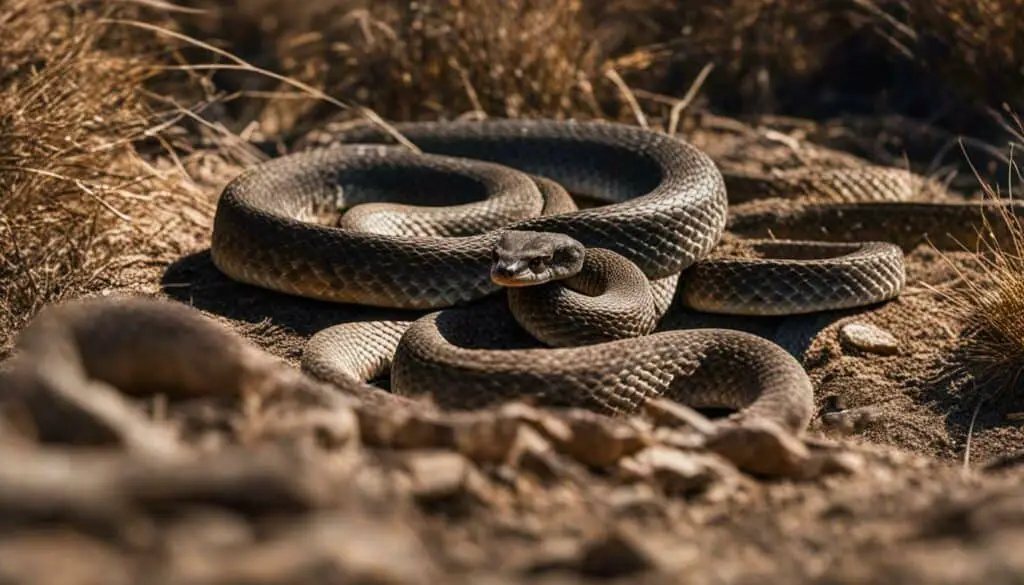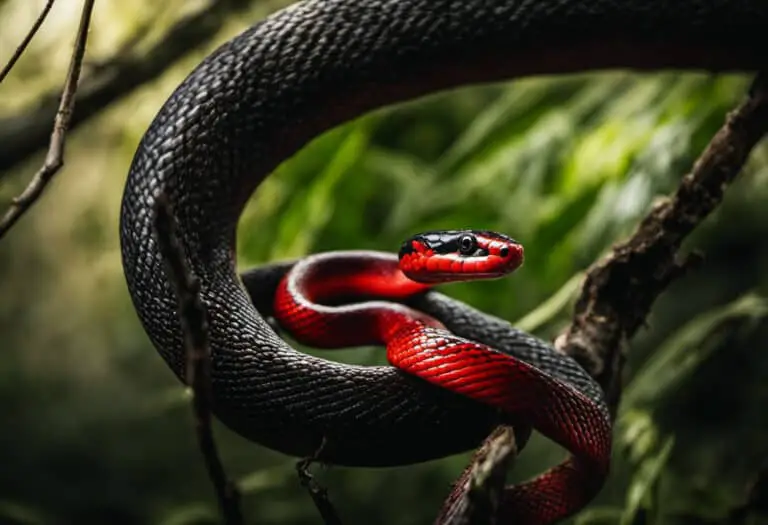Do Snakes Travel in Groups? Explore the Mystery!
Snakes are often perceived as solitary creatures, but there is a growing body of evidence suggesting that they do form social bonds and may travel in groups in certain circumstances. Rattlesnakes, for instance, are known to share resting spots and maternity dens with others of their species, while some nonvenomous snakes appear to form social bonds with specific individuals.
However, the majority of snakes prefer to travel alone and hunt for food and shelter on their own. Despite this, it is important to understand their behavior and respect their natural habitat to ensure their conservation.
Key Takeaways:
- Rattlesnakes may share resting spaces and maternity dens with others of their species, but they typically hunt alone.
- While some nonvenomous snakes form social bonds with specific individuals, the majority of snakes prefer to travel alone.
- Recent research suggests that snakes and other animals have social intelligence and a larger social repertoire than previously thought.
- Understanding snake behavior and respecting their natural habitat is essential for their conservation.
Social Behavior of Rattlesnakes
One example of a snake species that displays social behavior is the rattlesnake. While many people consider snakes to be solitary creatures, rattlesnakes have been observed engaging in social behaviors with others of their species in specific situations.
For instance, during mating season, male and female rattlesnakes may be seen together, rubbing heads or coiling their bodies around each other in a behavior known as the “mating dance.” While this behavior is not necessarily indicative of a social bond, it does demonstrate that rattlesnakes can interact with each other in a non-aggressive manner.
Rattlesnakes may also share resting spaces, including dens, especially with their young. While they may not coil up together, they do share these spaces. Some female rattlesnakes even congregate together in safe den areas while gestating.
Overall, the social behavior of rattlesnakes is complex and varies depending on factors such as mating, den sharing, and the presence of offspring. While they may not display social behavior like some other animals, the behavior of rattlesnakes challenges the notion that all snakes are solitary creatures.

Mating Behavior of Rattlesnakes
During the mating season, it is possible to observe male and female rattlesnakes together. While rattlesnakes are primarily solitary creatures, they may engage in social behavior during this time. This behavior may involve rubbing heads or coiling around each other. In some cases, males may engage in combat to win the attention of females.
Rattlesnakes lay pheromone trails to help their offspring find the den, and some offspring may continue to use the same den in subsequent years. However, this behavior does not qualify rattlesnakes as social animals. Rather, it is a survival strategy that allows offspring to find safe shelter during the winter months.
Rattlesnakes typically live as solitary animals, hunting and resting alone. It is only during brief interactions during mating season that they may exhibit social behavior. Even then, these interactions are primarily focused on reproducing and do not involve any long-term socialization.
Overall, the mating behavior of rattlesnakes is characterized by both solitary and social interactions. While they may engage in brief social behavior during mating season, they are primarily solitary creatures. This highlights the importance of respecting their space and observing them from a safe distance in their natural habitat.

“During the mating season, male and female rattlesnakes may come together, engaging in behaviors such as rubbing heads or coiling bodies.”
Shared Dens and Socialization Among Rattlesnakes
Shared dens are another example of social behavior among rattlesnakes. While most snakes prefer to hunt and travel alone, rattlesnakes have been observed sharing resting spaces, especially with their young. Hollows of trees or burrows left by rodents are common locations used as dens by rattlesnakes to rest and warm up during the winter.
Rattlesnakes typically hunt alone and do not travel in pairs, but during mating season, male and female rattlesnakes may be seen together, engaging in courtship behaviors. Mating pairs of rattlesnakes may spend time together until the mating process is complete. Shared dens are more common among related rattlesnakes, and some females may congregate together in safe den areas while gestating.
Moreover, rattlesnakes leave pheromone trails to help their young find the den. The offspring of rattlesnakes also share the den with their parents during the winter. While snakes usually do not travel in pairs, they may form social bonds and prefer certain companions. This phenomenon of socialization among snakes parallels similar behaviors observed in various animal species, indicating that snakes are not as solitary as previously thought.

“Social behavior is evident in rattlesnakes when it comes to shared dens. This is significant because it contradicts the common notion about snakes being solitary creatures. They may not be as social as pack animals, but they do have this tendency to share den spaces with their young or related individuals. “
Winter Denning and Offspring
During the winter, snakes, including rattlesnakes, retreat into their dens to survive the harsh temperatures. Rattlesnakes, in particular, may share dens with others of the same species, especially their young.
While rattlesnakes are typically solitary hunters, they exhibit social behavior during the winter months. Male and female rattlesnakes may be seen together during mating season, engaging in behaviors to court and mate.
Some species of rattlesnakes return to the same den year after year, and they may share the den with their offspring during the winter. This demonstrates a degree of social behavior and bonding among these snakes.
Garter snakes also exhibit social behavior during the winter months. They have been observed to seek out specific individuals that they have interacted with before and exhibit social cognition.
While snakes prefer to be alone for most of the time, the existence of social bonds and interactions among snakes challenges the perception that they are solitary creatures.

Winter denning and offspring is a fascinating topic that sheds light on the social behaviors of snakes during the winter season. While many snakes are solitary animals, certain species, like rattlesnakes and garter snakes, may engage in social behavior during the cold winter months.
Solitary Nature of Snakes
While rattlesnakes are an example of snakes that may exhibit social behavior to some extent, it is important to note that most snakes are solitary creatures. They prefer to hunt and travel alone, and only come together for mating or shared resting spaces. This behavior is due to a variety of factors, including competition for resources and the need to avoid predators.
When hunting, snakes rely on their stealth and ambush tactics to catch prey. Moving in groups would not provide any added advantage and may even result in competition for resources, such as larger prey or ideal hunting grounds. Therefore, solitary hunting is the most effective method for snakes to survive and thrive.
Additionally, many snake species have adaptations that allow them to regulate their body temperature, such as basking in the sun or seeking shade. Being on their own allows them to make the necessary adjustments to their environment without having to accommodate the preferences of others.
There are also some snake species that are more social than others, such as garter snakes, which have been found to form friendships with specific individuals. These partnerships are not based on reproduction or mating, but are believed to offer benefits such as heat retention and predator defense.
Overall, while social behavior does exist in some snake species, the majority of snakes prefer to lead solitary lives. Their hunting habits and need for environmental adjustments make solo travel the most effective strategy for their survival.

Conclusion
In conclusion, while snakes are generally solitary creatures, there are exceptions to this rule. As we have explored in this article, certain species like rattlesnakes are known to exhibit social behavior such as shared dens and mating rituals. However, the majority of snakes prefer to travel and hunt alone.
It is important to remember that while snakes may not be the cuddliest creatures, they play a crucial role in the ecosystem and should be respected and observed from a safe distance. Recent studies have shown that even garter snakes, typically believed to be solitary, have been found to seek out specific individuals to socialize with. These friendships may offer benefits such as heat retention and defense against predators.
So, while snakes may not travel in packs like wolves or chimps, they do have their own unique social behavior and preferences. As with any wild animal, it is important to appreciate and learn from these behaviors while also giving the snakes the space they need to thrive in their natural habitat.
FAQ
Q: Do snakes travel in groups?
A: While most snakes are solitary creatures, there are exceptions to this rule. Some snake species, such as rattlesnakes, may exhibit social behavior to some extent, particularly during mating and winter denning. However, the majority of snakes prefer to travel alone and do not form groups for hunting or other activities.
Q: What is an example of a snake species that displays social behavior?
A: One example of a snake species that displays social behavior is the rattlesnake. Although most rattlesnakes live as solitary animals, they occasionally share resting spaces with others of the same species, especially their young. However, when it comes to hunting, rattlesnakes are solo hunters and do not travel in groups or hunt in pairs.
Q: Do rattlesnakes travel together during mating?
A: During the mating season, it is possible to observe male and female rattlesnakes together. However, this does not mean that they are traveling or hunting together. The male tries to gain the female’s interest by rubbing his head on her or coiling his body around hers. Once the female either accepts or declines the male’s invitation to mate, they separate.
Q: Do rattlesnakes share dens?
A: Shared dens are another example of social behavior among rattlesnakes. While they may not coil up together to sleep, multiple snakes may use the same den and share the space. These shared dens are more common among rattlesnakes that are related to each other. Additionally, some female rattlesnakes may congregate together in safe den areas while gestating.
Q: Do snakes travel in packs during winter?
A: During the winter, snakes, including rattlesnakes, retreat into their dens to survive the harsh temperatures. While adult rattlesnakes are typically on their own, they lay pheromone trails to help their young find the den. For the winter months, the young snakes share the den with the adults, and some of them may even adopt the den as their own for subsequent winters.
Q: Are all snakes solitary creatures?
A: While rattlesnakes are an example of snakes that may exhibit social behavior, it is important to note that most snakes are solitary creatures. They prefer to roam and search for food and shelter on their own. Snakes typically do not travel in pairs or groups, and seeing two snakes together is often just a chance encounter rather than a regular occurrence.





